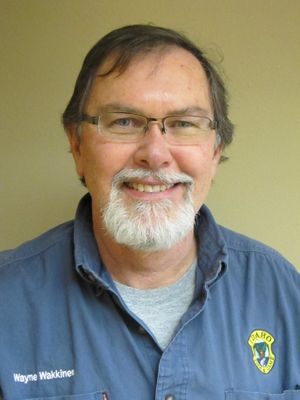Surveys: St. Joe elk show signs of increase
HUNTING -- Surveys conducted this winter showed a substantial increase in elk calf-cow ratios for elk in portions of North Idaho as the region's elk seem to be digging out of six-year slump.
Up to just a few years ago, the Panhandle Region was among the very few places in the United States that had a general either-sex elk hunt open to hunters with modern centerfire rifles.
In Washington, Montana and most other states, hunters had to draw a "cow tag" in order to participate in controlled hunts for antlerless elk or participate hunts with weapon restrictions such as archery-only seasons.
Two hard winters starting in 2007 delivered a blow to the region's big game. In 2012, low calf-cow ratios caused Idaho wildlife managers to eliminate the general either-sex elk hunt.
That got hunters' attention.
"The low ratios were not caused by a single issue, but rather a combination of factors," said Wayne Wakkinen, Idaho Department of Fish and Game regional wildlife manager. "These include declining habitat quality, predation by black bears and mountain lions and wolves, changes in the ability of people to access areas and technology that can increase hunting success rates."
Winter severity and summer drought also are factors, he said.
A mix of factors can create a cascading effect. "For example, declining habitat quality can result in cows in poor body condition," he said. "This in turn can result in lower birth weights of calves, something that’s been shown to be an important factor in calf survival. The condition of a cow elk can affect the ability to survive severe winters and to escape predators."
With no single cure-all prescription available for Panhandle elk woes, Wakkinen said the agency addressed the elk decline in several steps:
- Eliminating the general season on antlerless elk. An unpopular move, but it increased cow survival to preserve breeding stock necessary to rebuild herds.
- Liberalizing predator seasons. Black bear and mountain lion seasons have been lengthened and in some units hunters can use electronic calls and a second tag. Wolf hunting and trapping seasons have been lengthened region-wide and hunters and trappers can take multiple wolves.
- Working to improve the quality of elk habitat.
"Elk prefer younger forests that provide nutritious browse," Wakkinen said. "The 1910 fire and large fires in the 1920s and 1930s created expansive shrubfields that were conducive to a growing elk herd. That, coupled with widespread predator reductions, resulted in a very robust elk population starting in the 1950s."
However, those forests have matured. They don’t provide enough nutrition and in some area's they're so thick that elk become more vulnerable to predation.
The agency is working with the U.S. Forest service and other major landowners to give moose,elk and deer more consideration in forest management, he said. Prescribed fire and well-designed timber harvest are key to the effort.
Wakkinen said he sees progress.
"During winter surveys in the Panhandle, IDFG uses a ratio of 30 calves per 100 cows as a yardstick for a healthy elk herd. As recently as 2008, ratios were as high as 43 to100 in Unit 7 in the St Joe drainage, but ratios declined following the harsh winters of 2007-09.
"This isn’t unusual following a hard winter, but typically the ratio bounces back within a couple of years. Unfortunately, calf-cow ratios remained low in Unit 7, with winter surveys finding 9, 12 and 13 calves per 100 cows in 2012, 2013, and 2014."
The elk apparently were trapped what's known as a “predator pit,” he said.
For example, Central Montana pronghorn populations devastated by bad winters and disease have been struggling for years to recover partly because of a predator pit. Coyotes apparently are keying on the fewer number of does when they're dropping their fawns. In more normal times, say, 100 does might scatter to drop their fawns. Coyotes might sniff out and kill 20 fawns during the brief period when they're worth the effort to hunt instead of focusing on rodents. But if the herd has been reduced to 30 does having fawns, coyotes may still kill 20, but it's a much higher percentage of the crop and the herd cannot grow.
In the case of North Idaho elk, numbers were reduced by the winters, but predator numbers remained high because prolific white-tailed deer recovered quickly provided enough prey to support the bears, cougars and wolves. "The high number of predators can take enough elk to keep elk numbers low," Wakkinen said.
But surveys conducted this winter gave wildlife managers encouragement.
Ratios in Unit 7 above Avery averaged 30 calves per 100 cows and Unit 6 around Calder had more than 40 calves per 100 cows, Wakkinen said.
"Just like the cause of the decline, it is probably a combination of things," he said. Three consecutive mild winters certainly helped and liberal hunting seasons on predators and have likely helped elk escape from the predator pit, he added.
"If the current conditions remain the same or improve, we may see a continued improvement in the St Joe elk herds."
The Fish and Game Department ha a constitutional obligation to maintain native wildlife populations in the state, including predators, Wakkinen said. But the agency "will take steps to reduce predator numbers when they negatively impact elk or deer populations."
"Predation management is expensive and labor intensive and weather events are out of our control," he said. "Long term improvements in the quality of elk habitat are an essential part of the equation for insuring the continued existence of healthy Panhandle elk herds."

